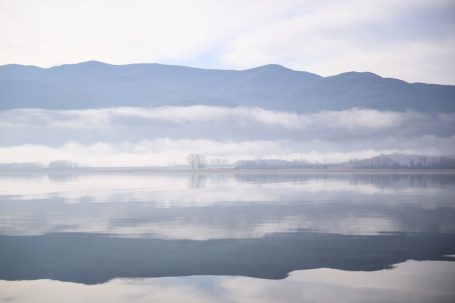09 Feb
2024
Background Information
Dalmatian Pelican
Although 312 bird species have been observed in Kerkini National Park the Dalmatian Pelican (Pelecanus crispus) is definitely the most prominent bird of Lake Kerkini.

It is a worldwide endangered species which was almost extinct in this region during the end of the 20th century due to persecution and habitat destruction. The local fishermen considered the birds food competitors, hunted them and destroyed their clutches.
Initially the lake served the birds only as feeding habitat. Pelicans fly up to 50 km in search for food. When they tried to breed in the area of Lake Kerkini their nests were washed away due to water level fluctuations.
To help the birds wooden nesting platforms were built starting in 2002 and the fishermen were made aware of the necessity to cooperate in the project
And the project has been very successful: after 7 breeding pairs in 2002 the numbers have risen to about 200 breeding pairs plus 400 young birds in recent years.
Today there is a peaceful coexistence between pelicans and fishermen. The fishermen help feeding the birds in winter with their bycatch as the pelicans are very poor divers and can’t reach the fish which goes down into the depths of the lake in winter. Nowadays many people are doing a lot for the pelicans:
they clean the shores of the lake and the banks of the river, they help building new platforms, they cut reeds for the pelicans to use as nesting material. Even a delegation traveled to Sofia to ask the Bulgarian government for help because so much plastic waste is being thrown into the Bulgarian part of the Strimonas River and being washed south to Lake Kerkini.
The Dalmatian pelicans belong to the biggest freshwater birds that are able to fly with a wing span of about 3 meters. With a weight of 10 -12 kg it’s not easy for them to take off the water but once they are flying they are brilliant flyers and thermal gliders and they are tireless.
They can fly 24 hours without taking a rest, up to 500 km in a height of 3000 meters.
At the age of 4 years they become sexually mature. They form monogamous pairs for the duration of the breeding season, they have 1-2 eggs per clutch. The breeding time is about 30 days. During the mating season from December to February they are very photogenic. Their beaks and throat bags take on a bright orange colour and they grow long and curly feathers on the head and the upper side of the neck which sometimes look like a mane. In this period they aren’t shy at all and come close to people because they are used to being fed over the winter months by the fishermen. It’s a really good opportunity to take pictures of these impressive birds. When the breeding season starts at the end of February they withdraw to the protected breeding platforms to the northeast of the lake to breed and raise their chicks.
Datenschutzerklärung | Impressum | © Annette Webersinke
Wir benötigen Ihre Zustimmung zum Laden der Übersetzungen
Wir nutzen einen Drittanbieter-Service, um den Inhalt der Website zu übersetzen, der möglicherweise Daten über Ihre Aktivitäten sammelt. Bitte überprüfen Sie die Details in der Datenschutzerklärung und akzeptieren Sie den Dienst, um die Übersetzungen zu sehen.






